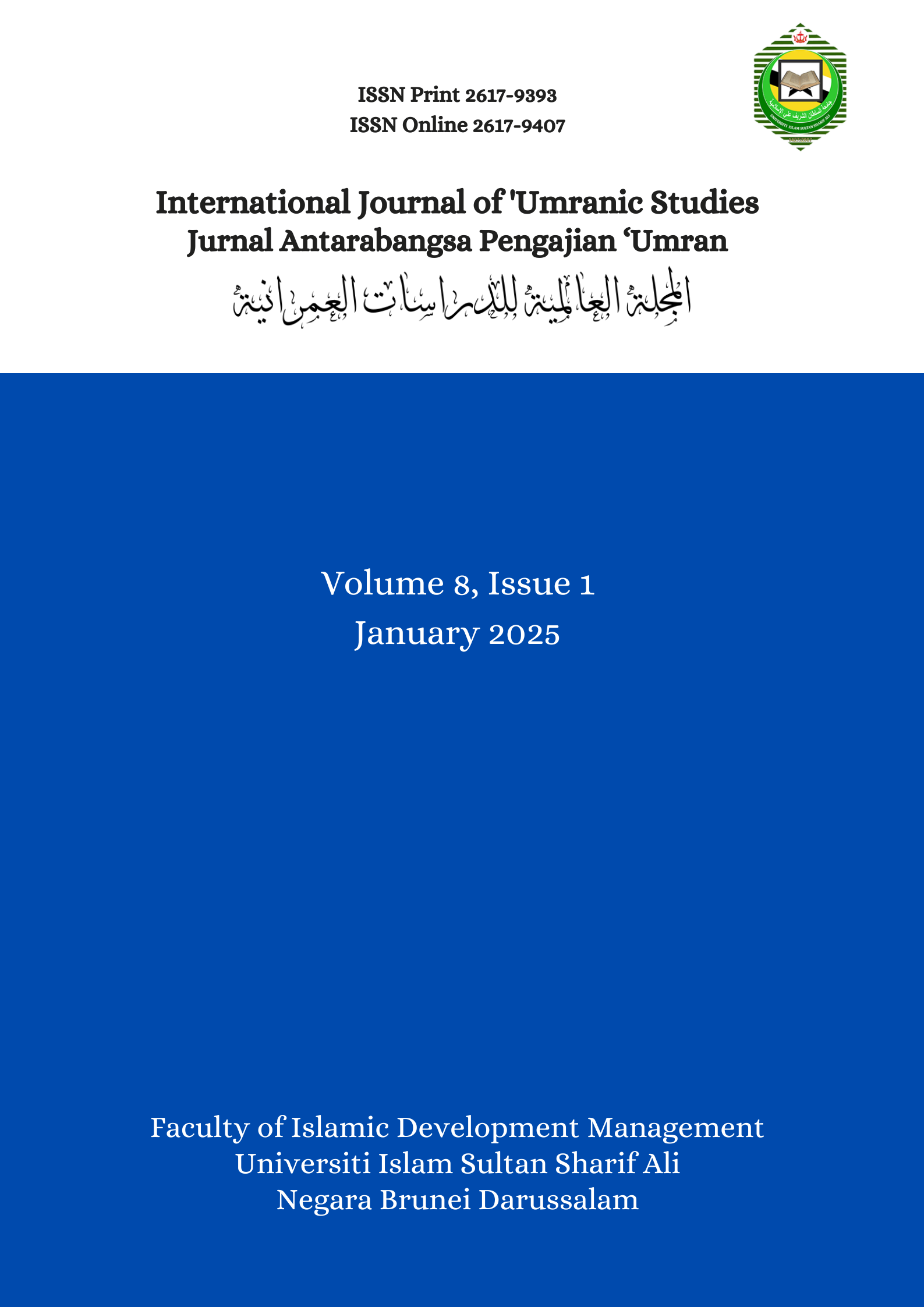ENHANCING ARABIC LANGUAGE LEARNING IN EARLY CHILDHOOD THROUGH PLAYING, STORYTELLING, AND SINGING (PSS) STRATEGIES
Published 2025-03-25
Keywords
- Arabic Language Learning,
- Early Childhood Education,
- PSS Strategy,
- Playing, Storytelling, Singing,
- Language Skills Development
- Child-Centered Learning ...More
How to Cite

This work is licensed under a Creative Commons Attribution 4.0 International License.
Copyright NoticeAbstract
Purpose of the Study: This study aims to explore the application of the PSS (Playing, Storytelling, and Singing) strategy in Arabic language learning for early childhood education. It seeks to emphasize how such engaging methods can enhance children’s motivation and language acquisition during their developmental golden age.
Methodology: This research adopts a qualitative library research approach by critically reviewing books, journal articles, and previous studies related to the PSS strategy. Data collection was conducted through documentation, and analysis was carried out using content analysis techniques to identify relevant patterns and themes.
Main Findings: The findings indicate that the PSS strategy is effective in enhancing Arabic language skills in early childhood, both receptive (listening and reading) and productive (speaking and writing). Specific examples such as "Chain Whispering" and "Snakes and Ladders" for playing, "Expressing the Picture" and "Say What I Drew" for storytelling, and thematic Arabic songs for singing, have shown positive impacts on vocabulary mastery, speaking fluency, and overall engagement in language learning.
Application of this Study: The study provides valuable pedagogical insights for Arabic language educators, curriculum developers, and early childhood education practitioners in designing interactive and developmentally appropriate Arabic language learning strategies.
Novelty/Originality of this Study: This study offers a comprehensive framework for implementing the PSS strategy specifically in Arabic language learning, combining theory and practice with practical teaching steps, media examples, and classroom activities tailored to young learners.
Significance: The research contributes to the growing body of knowledge in early childhood Arabic language education by highlighting innovative, enjoyable, and child-centered strategies that align with both linguistic and developmental needs, ultimately fostering deeper interest and long-term language competence among learners.
References
- Books
- Anggito, A., & Setiawan, J. (2018). Metodologi Penelitian Kualitatif. CV Jejak.
- Boysson-Bardies, B. de. (2001). How language comes to children: from birth to two years. MIT.
- Madyawati, L. (2016). Strategi Pengembangan Bahasa pada Anak. Jakarta: Kencana.
- Montessori. (2008). The Science Behind the Genius. Oxford University Press.
- Mushtofa, N. (1983). Al-Al’ab al-Lughowiyah fi al-Lughoh al-Ajnabiyah. Dar el-Murih.
- Patmonodewo, S. (2008). Pendidikan Anak Prasekolah. Rineka Cipta.
- Said, A., & Budimanjaya, A. (2016). 95 Strategi Mengajar Multiple Intelligences: Mengajar Sesuai Kerja Otak dan Gaya Belajar Peserta Didik. Kencana.
- Seefeldt, C. (2008). Pendidikan Anak Usia Dini. Indeks.
- Zed, M. (2014). Metode Penelitian Kepustakaan. Jakarta: Yayasan Pustaka Obor Indonesia.
- Journal Articles
- Ahmad, K. A. M. (2020). Al-Qishshoh al-Mubassithoh wa Dauruha fi Ta’lim al-Lughoh al-Arobiyah li al-Athfal al-Nathiqin bi Ghoiri al-Arobiyah. Majallah Al-Nathiqin by Ghoiri Al-Lughoh Al-Arobiyah, 3(5), 63–87.
- Akmaliyah, Hudzaifah, Y., Ulfah, N., & Pamungkas, M. I. (2021). Child-friendly teaching approach for Arabic language in Indonesian Islamic boarding school. International Journal of Language Education, 5(1), 501–514. https://doi.org/10.26858/IJOLE.V5I1.15297
- Al-Musuwi, M. H. (2021). Atsar Istirotijiyah Qul Ma Arsamuhu fi Iktisab al-Maharoh al-Imlaiyah lada Thullab al-Shof al-Awwal Mutawasith. Mustansiriyah Journal for Science and Education, 22(2), 505–516. https://edumag.uomustansiriyah.edu.iq/index.php/mjse/article/view/908
- Aldena, S. (2021). تطوير الأغاني للأطفال لترقية استيعاب المفردات العربية Developing Songs for Children to Upgrade the Arabic Vocabulary Comprehension. Jurnal Al-Maqayis: Jurnal Pendidikan Bahasa Arab Dan Kebahasaaraban, 8(1), 85–98. https://doi.org/10.18592/jams.v8i1.4800
- Alzulmi, S., Hidayat, T., & Usman, S. (2024). Efektivitas Penggunaan Teknik Bisik Berantai Dalam Meningkatkan Kemampuan Mendengar. Didaktik: Jurnal Ilmiah PGSD STKIP Subang, 10(3), 537–546. https://doi.org/10.36989/didaktik.v10i3.3624
- Amiruddin, A., Mannahali, M., & Muthmainnah, S. (2022). Efektivitas Metode Permainan Bisik Berantai Dalam Maharah Istima’ Siswa Kelas VIII MTs Attaufiq Padaelo Kabupaten Barru. Al-Fashahah: Journal of Arabic Education, Linguistics, And Literature, 2(1), 31–38. https://doi.org/10.59562/al-fashahah.v2i1.34046
- Anggraini, T. R., Wicaksono, A., Nirmala, I., & Audia, M. P. (2023). Pelatihan BCM (bermain, cerita, dan menyanyi) untuk meningkatkan motivasi siswa TK Kartini II Bandar Lampung. Kreasi: Jurnal Inovasi Dan Pengabdian Kepada Masyarakat, 3(1), 26–36. https://doi.org/10.58218/kreasi.v3i1.456
- Aprianti, E. (2017). Penerapan Pembelajaran BCM (Bermain, Cerita, Menyanyi) untuk Mengembangkan Kecerdasan Emosional Anak Usia Dini Di Kober Baiturrohim Kabupaten Bandung Barat. Tunas Siliwangi: Jurnal Program Studi Pendidikan Guru PAUD STKIP Siliwangi Bandung, 3(2), 195–211. https://doi.org/10.22460/ts.v3i2p195-211.651
- Aziz, A., Suhada, & Masruri, A. (2022). Aktivitas Pembelajaran Bahasa Arab Anak Usia Dini dengan Pendekatan Psikologi Humanistik Carl R. Rogers. El-Athfal: Jurnal Kajian Ilmu Pendidikan Anak, 2(02), 64–78. https://doi.org/10.56872/elathfal.v2i02.831
- Azzahra, S. (2023). Pengaruh Metode Bernyanyi terhadap Penguasaan Kosakata Bahasa Inggris pada Siswa SD. Jurnal Pendidikan Guru Sekolah Dasar, 1(2), 1–9. https://doi.org/10.47134/pgsd.v1i2.142
- Baharun, S., & Sahri. (2022). Istirotijiyyah Ta’lim al-Lughoh al-’Arobiyyah fi Marhalah al-Thufulah al-Mubakkiroh. Lahjatuna: Journal of Arabic Education, 1(2), 154–178. https://doi.org/10.38073/lahjatuna.v1i2.842
- Bengtsson, M. (2016). How to plan and perform a qualitative study using content analysis. NursingPlus Open, 2, 8–14. https://doi.org/10.1016/j.npls.2016.01.001
- Dew, A., De Bortoli, T., Brentnall, J., & Bundy, A. (2014). Strengthening Supports for Children 0–8 Years and their Families: A Literature Review. The University of Sydney.
- Endahwati, M., Bachri, B. S., & Izzati, U. A. (2022). Efektivitas Metode Pembelajaran Read Aloud Dengan Media Buku Cerita Gambar Seri Untuk Meningkatkan Kemampuan Berbahasa Reseptif Dan Ekspresif Pada Anak Usia Dini. Jurnal PAJAR (Pendidikan dan Pengajaran), 6(1), 163–174. http://dx.doi.org/10.33578/pjr.v6i1.8496
- Erlingsson, C., & Brysiewicz, P. (2017). A hands-on guide to doing content analysis. African Journal of Emergency Medicine, 7(3), 93–99. https://doi.org/10.1016/j.afjem.2017.08.001
- Fadlan, A. (2019). Efektivitas Metode Bercerita Dalam Perkembangan Bahasa Anak. Smart Kids Jurnal Pendidikan Islam Anak Usia Dini, 1(1), 28–37. https://doi.org/10.30631/smartkids.v1i1.47
- Faridah, L. U. (2017). Pengenalan Bahasa Arab Untuk Anak Sejak Dini. Prosiding Konferensi Nasional Bahasa Arab, 3(3), 411–419.
- Fowler, R. C. (2023). An Examination of Educator Standards for Early Grade Teachers. Journal of Early Childhood Teacher Education, 44(3), 189–207. https://doi.org/10.1080/02568543.2023.2221719
- Halimah, S. (2022). Strategi Penerapan Tariqah Mubasyarah Dalam Pembelajaran Bahasa Arab Tingkat Madrasah Ibtidaiyah. Asas Wa Tandhim: Jurnal Hukum, Pendidikan Dan Sosial Keagamaan, 1(2), 215–228. https://doi.org/10.47200/awtjhpsa.v1i2.1621
- Hasan, H. (2018). Media Musik (Lagu) Dalam Pembelajaran Bahasa Arab Tingkat MI. Al Qalam: Jurnal Ilmiah Keagamaan Dan Kemasyarakatan, 9(17), 55–74. https://doi.org/10.35931/aq.v0i0.53
- Herman, H., Samad, S., & Dzulfadhilah, F. (2022). The Effect of the Chain Whisper Game on Children’s Receptive Language Skills. RETORIKA: Jurnal Bahasa, Sastra, Dan Pengajarannya, 15(2), 107–113. https://doi.org/10.26858/retorika.v15i2.40412
- Huda, M. A. N. and Fauji, I. (2024). Efektivitas Penerapan Metode Bernyanyi Terhadap Peningkatan Pemahaman Kosakata Bahasa Arab. Pendas: Jurnal Ilmiah Pendidikan Dasar, 9(1), 1240–1253. https://doi.org/10.23969/jp.v9i1.12548
- Isbah, F., Taufiq, A., Jamaludin, A., & Munir, M. (2022). Strategi Pembelajaran Bahasa Arab pada Pendidikan Anak Usia Dini. Jurnal Asghar, 2(1), 26–37. https://doi.org/10.28918/asghar.v2i1.5751
- Istiqomah, H., & Hidayah, Z. H. (2020). Tathbîq Al Lu’Batain “Hims Al Fi’L" Wa “Al ‘Idd Wa Al Tashfîq” Fî Smp Plus Cordova Banyuwangi. Al Mi’yar: Jurnal Ilmiah Pembelajaran Bahasa Arab Dan Kebahasaaraban, 3(1), 63–90. https://doi.org/10.35931/am.v3i1.203
- Istiqomah, H., Murtadho, Nurul Mahliatussikah, H., Riskawati, Y. K., & Al-Badrani, M. J. H. (2022). Ta’tsir al-Kafa’ah al-Akadimiyah wa Hafiz al-Ta’allum fi Tarqiyah Maharah Qiraah al-Qur’an al-Asasiyah bi Kitab Himmati. Majallah Al-Ta’limiyah, 12(2), 159–170.
- Juniati, R., Amal, A., & Syamsuardi. (2022). Chain Whispering Games: The Effective Methods of Developing Receptive Language Skills of Children Aged 5–6 Years. CEJ: Child Education Journal, 4(1), 13–24. https://doi.org/10.33086/cej.v4i1.2889
- Khomsin & Rahimmatussalisa. (2021). Efektivitas Media Permainan Ular Tangga untuk Meningkatkan Kemampuan Mengenal Kosakata Bahasa Inggris pada Anak Usia Dini. Jurnal Pendidikan Anak, 10(1), 25–33. https://journal.uny.ac.id/index.php/jpa
- Maphalala, Z., Pascoe, M., & Smouse, M. R. (2014). Phonological development of first language isiXhosa-speaking children aged 3;0–6;0 years: A descriptive cross-sectional study. Clinical Linguistics & Phonetics, 28(3), 176–194. https://doi.org/10.3109/02699206.2013.840860
- Mardliyyah, A., & Baroroh, R. U. (2019). Development of the Ladder Snake Game Media in Arabic Learning/Pengembangan Media Permainan Ular Tangga Dalam Pembelajaran Bahasa Arab. Ijaz Arabi Journal of Arabic Learning, 2(1), 64–76.
- Mualif, A. (2022). Methodology of Learning Arabic Language At Children’s Age. International Business Research Conference on Science and Technology, 92–95. https://doi.org/10.36378/internationalconferenceuniks.v0i0.2832
- Muid, F. A. (2024). Efektivitas Permainan Ular Tangga untuk Meningkatkan Keterampilan Kalam Siswa-Siswi MTs Al-Qur’an Terpadu Darut Ta’lim An Nawawi Surabaya. Lisan An Nathiq: Jurnal Bahasa Dan Pendidikan Bahasa Arab, 6(1), 135–147. https://doi.org/10.53515/lan.v6i1.616
- Munandar, V., & Friska, N. (2024). Efektivitas Media Permainan Ular Tangga Terhadap Penguasaan Kosata Bahasa Inggris Pada Anak Kelompok A Di Ra Nur Aisyah. Didaktik: Jurnal Ilmiah PGSD STKIP Subang, 10(3), 472–477. https://doi.org/10.36989/didaktik.v10i3.4184
- Mutia, E. (2023). Efektivitas Metode Permainan Bahasa Bisik Berantai Terhadap Peningkatan Keterampilan Menyimak Siswa Kelas Iv Sd Negeri 0501 Hutanopan. Al Ihtirafiah: Jurnal Ilmiah Pendidikan Guru Madrasah Ibtidaiyah, 3(2), 73–82. https://doi.org/10.47498/ihtirafiah.v3i02.2347
- Nadiroh, N., Wijaya, T., & Usman, S. (2018). Fa’aliyah Istikhdam al-Wasilah al-Ta’limiyah “Ta’bir Shuwar” fi Iktisab Maharah al-Kalam. JCM: Jurnal Cahaya Mandalika, 3(1), 1223–1232.
- Nurhidayati, Irhamni, & Ainin, M. (2020). Learning Strategy Patterns in Developing Skills for Listening of Arabic Speech. Isolec: International Seminar on Language, Education, and Culture, 223–236. https://doi.org/10.18502/kss.v4i4.6486
- Nurlaila, & Rahman, A. (2018). Penggunaan Media Ular Tangga Untuk Meningkatkan Kemahiran Berbicara Bahasa Arab Siswa Pondok Pesantren Darul Hikmah Soncolela Kota Bima. AL-AF’IDAH: Jurnal Pendidikan Bahasa Arab Dan Pengajarannya, 2(1), 52–68. https://doi.org/10.52266/al-afidah.v2i1.164
- Pérez-Ferra, M., Quijano-López, R., & García-Martínez, I. (2020). Impact of educational habits on the learning of 3-6 year old children from the perspective of early childhood education teachers. Sustainability (Switzerland), 12(11), 1–16. https://doi.org/10.3390/su12114388
- Putri, D. A. P. (2019). Rancang Bangun Media Pembelajaran Bahasa Arab Untuk Anak Usia Dini Berbasis Android. Technologia: Jurnal Ilmiah, 10(3), 156–164. http://dx.doi.org/10.31602/tji.v10i3.2230
- Ramadhan, S. (2017). Strategi Pembelajaran Bahasa Arab Pada Anak Usia Dini. Utile; Jurnal Kependidikan, 3(2), 180–189. https://doi.org/10.37150/jut.v3i2.75
- Ridwan, R., & Awaluddin, A. F. (2019). Penerapan Metode Bernyanyi Dalam Meningkatkan Penguasaan Mufradat Dalam Pembelajaran Bahasa Arab Di Raodhatul Athfal. DIDAKTIKA: Jurnal Kependidikan, 13(1), 56–67. https://doi.org/10.30863/didaktika.v13i1.252
- Rizal, S. S., Kamila, I. N., Hanifunni’am, F. F., Masitoh, A. I. S., & Dewi, T. T. (2022). Upaya Meningkatkan Kemampuan Berbahasa Melalui Metode Bernyanyi Pada Anak Usia 3-4 Tahun Kober Al Falah Cijeungjing. Jurnal Dedikasi, 3(1). https://open.jyijr.net/index.php/jd/article/view/120
- Rosalinda. (2021). Pengaruh Permainan Bahasa Terhadap Pembelajaran Bahasa Arab Di Sekolah Dasar Negeri 09 Dewantara. Serambi Konstruktivis, 3(2), 41–49. https://doi.org/10.32672/konstruktivis.v3i2.3216
- Sadiana, M. (2016). Implementation Of BCM Methods (Playing, Stories, And Singing) To Developing Social-Emotional Intelligence Of Early Childhood. TRIADIK, 15(2), 9–16. https://doi.org/10.33369/triadik.v15i2.2864
- Said, O. A. (2023). Music as a Didactic Medium in the Learning of Amazigh Language. Meridian of Criticism, 43(2), 213–227. https://www.ceeol.com/search/viewpdf?id=1308073
- Salim, H., & Mohamed, S. (2023). Preschool Teachers’ Perception of the National Curriculum Standard for Preschool. International Journal of Academic Research in Progressive Education and Development, 12(3), 266–277. https://doi.org/10.6007/ijarped/v12-i3/18462
- Shiel, G., Cregan, A., McGough, A., & Archer, P. (2012). Oral Language in Early Childhood and Primary Education (3-8 years) (Issue 14).
- Shodiq, A. J. (2018). Nadhoriyat Uslub Ta’bir al-Shuwar fi Ta’lim Maharoh al-Kitabah. Imtiyaz: Jurnal Pendidikan Dan Bahasa Arab, 2(2), 99–107. https://doi.org/10.29300/im.v2i2.1761
- Tasya, A. M. (2021). Strategi Pembelajaran Bahasa Arab. Prosiding Seminar Nasional Mahasiswa Bahasa Arab, 202–215. http://prosiding.arab-um.com/index.php/semnasbama/article/view/786/734
- Teng, A. Y. T., Liang, C. Y., & Liu, Y. C. G. (2021). Socio-economic status may associate different risk(S) with early childhood caries (ECC) that can cause the development of psychomotor deficiency in preschool children aged 3–6 years old: The results of preliminary analysis from a cohort study. International Journal of Environmental Research and Public Health, 18(17), 1–13. https://doi.org/10.3390/ijerph18179011
- Wake, M., Tobin, S., Girolametto, L., Ukoumunne, O. C., Gold, L., Levickis, P., Sheehan, J., Goldfeld, S., & Reilly, S. (2011). Outcomes of population based language promotion for slow to talk toddlers at ages 2 and 3 years: Let’s learn language cluster randomised controlled trial. BMJ (Online), 343(7821), 1–10. https://doi.org/10.1136/bmj.d4741
- Yassin, R., Share, D. L., & Shalhoub-Awwad, Y. (2020). Learning to Spell in Arabic: The Impact of Script-Specific Visual-Orthographic Features. Frontiers in Psychology, 11(August). https://doi.org/10.3389/fpsyg.2020.02059
- Zein. R. & Puspita, V. (2021). Efektivitas Pengembangan Model Bercerita terpadu terhadap Kemampuan Berbahasa Anak Usia 5-6 Tahun. Jurnal Obsesi: Jurnal Pendidikan Anak Usia Dini, 5(2), 2168–2178. https://doi.org/10.31004/obsesi.v5i2.1123



